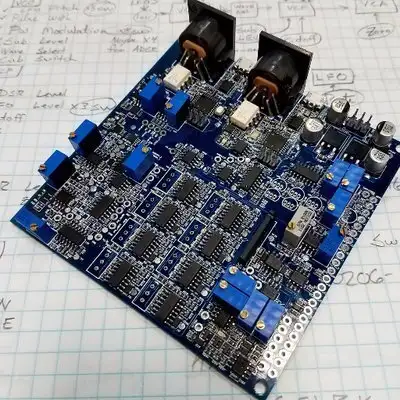MEP EP#196: Foamy Power Factors - Electrolytic Capacitors with KEMETEpisode 200 is Coming Up!
Question / Answer setup like Episode 100
Send them via Audio Format to podcast@macrofab.com
Ivan Quiroz
Over 19 years of electronic design and development experience in different industries ranging from aviation to industrial automation
His technical expertise surrounds the intrinsic requirements and detailed development of circuits
In his down time, he likes to develop escape room puzzles, sensors, and anything he can 3D print
Suzana Jankuloska
Is an electrical engineer from Macedonia
Has been with KEMET for 7 years and as a Product Manager of Electrolytic Capacitors for 3 years
Loves solving problems and sudoku and is a fan of martial arts and the movie Ip Man
Electrolytic Capacitors
Discuss ESR, ESL, Dissipation factor, Tan Delta, Ripple current, and life span
How to read the datasheet for an electrolytic capacitor beyond the value/voltage/dimensions
impedance at a known switching frequency
Brief introduction to a new type of electrolytic capacitor (polymer)
Link the electrolytic capacitor to the need for a bank capacitors
Signals through electrolytics
Leave on forever vs. multiple inrush cycles preferred for lifetime?
What drifts out of spec first?
The wear-out failure mode is loss of electrolyte
It is possible to measure this by weighing the capacitor before and after operating it at elevated temperature
When the capacitor loses a certain amount of weight, it is likely to fail
In the old days, the rule of thumb was to predict failure at 50% of the initial weight
What's the point of those orange SMD tantalum capacitors?
On large screw terminal caps, are the screws themselves typically intended to carry current, or just to mechanically tie the cap to the mounting surface (bus bar, PCB, etc.)?
Is it important to use aluminum screws to match materials to avoid corrosion from dissimilar metals in high current applications?
Show Notes
MEP EP#196: Foamy Power Factors - Electrolytic Capacitors with KEMET
Episode 200 is Coming Up!
- Question / Answer setup like Episode 100
- Send them via Audio Format to podcast@macrofab.com
Ivan Quiroz
- Over 19 years of electronic design and development experience in different industries ranging from aviation to industrial automation
- His technical expertise surrounds the intrinsic requirements and detailed development of circuits
- In his down time, he likes to develop escape room puzzles, sensors, and anything he can 3D print
Suzana Jankuloska
- Is an electrical engineer from Macedonia
- Has been with KEMET for 7 years and as a Product Manager of Electrolytic Capacitors for 3 years
- Loves solving problems and sudoku and is a fan of martial arts and the movie Ip Man
Electrolytic Capacitors
- Discuss ESR, ESL, Dissipation factor, Tan Delta, Ripple current, and life span
- How to read the datasheet for an electrolytic capacitor beyond the value/voltage/dimensions
- impedance at a known switching frequency
- Brief introduction to a new type of electrolytic capacitor (polymer)
- Link the electrolytic capacitor to the need for a bank capacitors
- Signals through electrolytics
- Leave on forever vs. multiple inrush cycles preferred for lifetime?
- What drifts out of spec first?
- The wear-out failure mode is loss of electrolyte
- It is possible to measure this by weighing the capacitor before and after operating it at elevated temperature
- When the capacitor loses a certain amount of weight, it is likely to fail
- In the old days, the rule of thumb was to predict failure at 50% of the initial weight
- What's the point of those orange SMD tantalum capacitors?
- On large screw terminal caps, are the screws themselves typically intended to carry current, or just to mechanically tie the cap to the mounting surface (bus bar, PCB, etc.)?
- Is it important to use aluminum screws to match materials to avoid corrosion from dissimilar metals in high current applications?
Creators & Guests
What is Circuit Break - A MacroFab Podcast?
Dive into the electrifying world of electrical engineering with Circuit Break, a MacroFab podcast hosted by Parker Dillmann and Stephen Kraig. This dynamic duo, armed with practical experience and a palpable passion for tech, explores the latest innovations, industry news, and practical challenges in the field. From DIY project hurdles to deep dives with industry experts, Parker and Stephen's real-world insights provide an engaging learning experience that bridges theory and practice for engineers at any stage of their career.
Whether you're a student eager to grasp what the job market seeks, or an engineer keen to stay ahead in the fast-paced tech world, Circuit Break is your go-to. The hosts, alongside a vibrant community of engineers, makers, and leaders, dissect product evolutions, demystify the journey of tech from lab to market, and reverse engineer the processes behind groundbreaking advancements. Their candid discussions not only enlighten but also inspire listeners to explore the limitless possibilities within electrical engineering.
Presented by MacroFab, a leader in electronics manufacturing services, Circuit Break connects listeners directly to the forefront of PCB design, assembly, and innovation. MacroFab's platform exemplifies the seamless integration of design and manufacturing, catering to a broad audience from hobbyists to professionals.
About the hosts: Parker, an expert in Embedded System Design and DSP, and Stephen, an aficionado of audio electronics and brewing tech, bring a wealth of knowledge and a unique perspective to the show. Their backgrounds in engineering and hands-on projects make each episode a blend of expertise, enthusiasm, and practical advice.
Join the conversation and community at our online engineering forum, where we delve deeper into each episode's content, gather your feedback, and explore the topics you're curious about. Subscribe to Circuit Break on your favorite podcast platform and become part of our journey through the fascinating world of electrical engineering.

